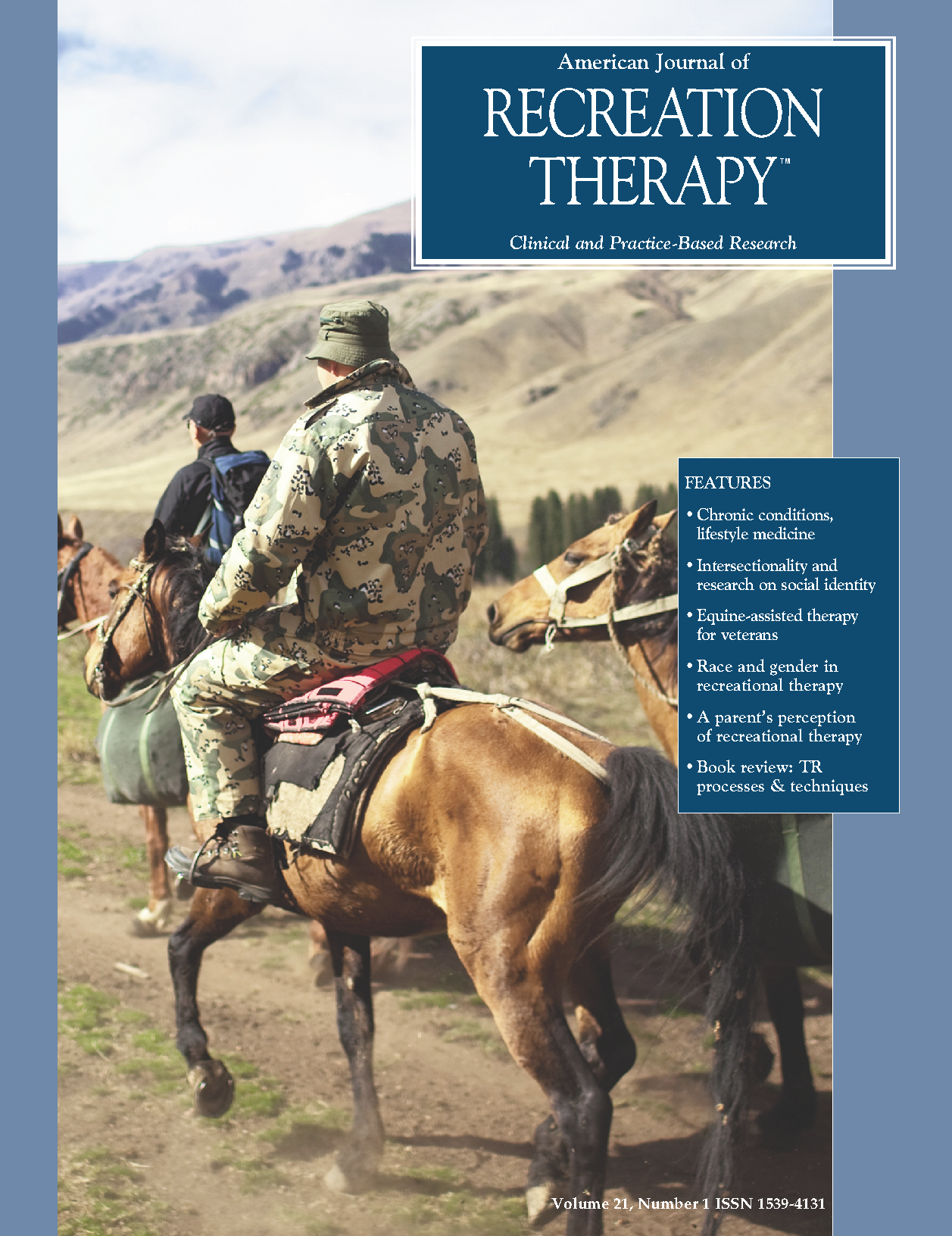A parent’s perception of the impact of recreational therapy on their child’s quality of life with cerebral palsy: A case study
DOI:
https://doi.org/10.5055/ajrt.2022.0255Keywords:
cerebral palsy, quality of life, pediatric, perception of quality of life, recreational therapyAbstract
There is a need for research centered around recreational therapy, cerebral palsy (CP), and quality of life (QOL). This study focused on one parent’s perceptions of their child’s QOL with spastic CP before and after receiving recreational therapy treatment. The PedsQL™ Infant Scales was utilized for this study in a pretest/post-test case report. Data were collected from the participant at a health center in Stillwater, Oklahoma. The data collected determined that the parent did perceive an improvement in QOL of their child with CP after receiving recreational therapy treatment. There is a minimal research in the specific areas of recreational therapy for CP and the effect that recreational therapy has on a child’s QOL with CP; however, this study helps build the foundation for future studies.
References
Texas Adoption Resource Exchange: A closer look at cerebral palsy. Texas Department of Family and Protective Services Website. Available at https://www.dfps.state.tx.us/Adoption_and_Foster_Care/About_Our_Children/Disabilities/cerebral_palsy.asp. Accessed August 30, 2020.
Cerebral Palsy Alliance: Facts about cerebral palsy. Cerebral Palsy Alliance Research Foundation Website. Available at https://cparf.org/what-is-cerebral-palsy/factsabout-cerebral-palsy/. Accessed August 30, 2020.
Centers for Disease Control and Prevention: Data and statistics for cerebral palsy. Centers for Disease Control and Preventions. Updated April 30, 2019. Available at https://www.cdc.gov/ncbddd/cp/data.html. Accessed August 30, 2020.
Becker B: Aquatic therapy: Scientific foundations and clinical rehabilitation applications. J Phys Med Rehabil. 2009; 1(9): 859-872. DOI: 10.1016/j.pmrj.2009.05.017.
Becker B, Cole A: Comprehensive Aquatic Therapy. 3rd ed. Pullman, WA: Washington State University, 2011.
Passmore T, Gbur T, Lindenmeier D, et al.: Warmwater—A recreational therapy intervention: A case report. Am J Recreat Ther. 2018; 17(1): 21-28. DOI: 10.5055/ajrt.2018.0151.
Robinson N, Lorenc A, Liao X: The evidence for shiatsu: A systematic review of shiatsu and acupressure. BMC Complement Altern Med. 2011; 11(1): 88-103.
Burton L, Brigham H: Proprioceptive neuromuscular facilitation: The foundational of functional training. Functional movement website. 2013. Available at https://www.functionalmovement.com/Articles/127/proprioceptive_neuromuscular_facilitation_the_foundation_of_functional_training. Accessed September 15, 2019.
Kim E, Lee D, Kim Y: Effects of aquatic PNF lower extremity patterns on balance and ADL of stroke patients. J Phys Ther Sci. 2015; 27(1): 213-215. DOI: 10.1589/jpts.27.213.
Salzman A: How to define aquatic specialty techniques: Operational definitions. 2007. Available at http://www.aquaticnet.com/Article%20-%20How%20to%20define%20aquatic%20specially%20techniques.htm. Accessed September 15, 2019.
World Health Organization: WHOQOL: Measuring Quality of Life. World Health Organization, 1997: 1-13.
Centers for Disease Control and Prevention: HRQOL concepts. Centers for Disease Control and Preventions. 2018. Updated October 31, 2018. https://www.cdc.gov/hrqol/concept.htm. Accessed September 15, 2019.
Varni J, Seid M, Rode C: The PedsQL: Measurement model for the pediatric quality of life inventory. Med Care. 1999; 37(2): 126-139. DOI: 10.1097/00005650-199902000-00003.
Radsel A, Osredkar D, Neubauer D: Health-related quality of life in children and adolescents with cerebral palsy. Slovenian J Public Health. 2017; 56(1): 1-10. DOI: 10.1515/sjph-2017-0001.
Majnemer A, Shevell M, Law M, et al.: Reliability in the ratings of quality of life between parents and their children of school age with cerebral palsy. Qual Life Res. 2008; 17(9): 1163-1171. DOI: 10.1007/s11136-008-9394-6.
Arnaud C, White-Koning M, Michelsen S, et al.: Parent-reported quality of life of children with cerebral palsy in Europe. Pediatrics. 2008; 121(1): 54-64. DOI: 10.1542/peds.2007-0854.
Varni J, Limbers C, Neighbors K, et al.: The PedsQL infant scales: Feasibility, internal consistency reliability, and validity in healthy and ill infants. Qual Life Res. 2011; 20(1): 45-55. DOI: 10.1007/s11136-010-9730-5.
Published
How to Cite
Issue
Section
License
Copyright 2000-2025, Weston Medical Publishing, LLC and American Journal of Recreation Therapy. All Rights Reserved.


